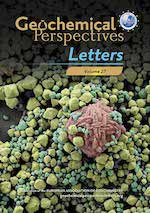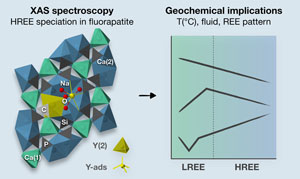 | Sorption model for yttrium in fluorapatite: Geochemical implications Abstract: Fluorapatite (FAp), which occurs in various geological settings, contains rare earth elements (REE) for which unveiling the crystal chemistry is a key geochemical issue, especially for unravelling the conditions of fractionation and crystallisation. However, no consensus has been reached regarding their binding modes in FAp, with studies suggesting REE3+-Ca2+ substitution at the Ca(1) site, or at the Ca(2) site, or involving adsorption mechanisms. Our contribution here is based on yttrium K-edge X-ray absorption spectroscopy (XAS), performed on two genetically contrasting minerals: a hydrothermal FAp (from Durango, Mexico), and a sedimentary phosphorite (from Morocco). The results clearly show that Y substitutes for the Ca(2) site in both FAp. However, the spectral differences observed for the sedimentary FAp (B-type carbonated-FAp) suggest a sorption model that is either i) a mixture of Y-Ca(2) substitution and Y-adsorbed as an inner shell complex, or ii) Y-Ca(2) substitution along with carbonate groups replacing phosphate groups in the surrounding atomic shell. These models of yttrium sorption in FAp shed new light on the understanding of rare earth partitioning and enrichment processes, with major geochemical implications such as i) the identification of crystallising fluids and temperature in magmatic-hydrothermal settings, and ii) preservation of past seawater-porewater conditions in sedimentary settings. |
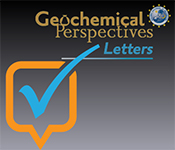 | Corrigendum to “Co-reduction of Fe(III) and S0 drives Fe-S biomineral formation and phosphate mobilisation” by Bronner et al., 2023 |
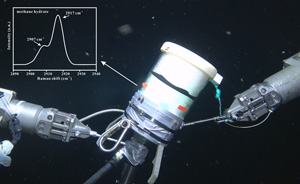 | The direct observation and interpretation of gas hydrate decomposition with ocean depth Abstract: An exposed gas hydrate (EGH) evolutional model as a function of water depth was established by in situ EGHs ascent experiments in cold seep areas of Haima (1509 m, 2.88 °C and 15.22 MPa), Lingshui (1760 m, 2.56 °C, 17.76 MPa and pH = 7.97) and Site F (1100 m, 3.57 °C, 11.09 MPa and pH = 7.69) in the South China Sea. A remotely operated vehicle was used to reproduce the in situ EGH ascent. Changes and temperature variations during EGH ascent were monitored in real time using a Raman insertion probe and dissolved oxygen sensor. The EGH ascent involved three stages of change: i) the metastable stage where no morphology changes, but where gas escapes and there is a decrease in internal temperature; ii) a second stage of coexistence of peripheral hydrate decomposition and internal hydrate growth; iii) a third stage of internal hydrate decomposition at shallower depths. Experimental results indicated that EGHs can carry gas bubbles to shallow depths and even to the sea surface. This could be an important transport mode for cold seep gases affecting shallow waters or the atmosphere. |
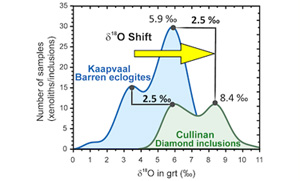 | Contrasting oxygen isotopes in garnet from diamondiferous and barren eclogitic parageneses Abstract: Eclogite is a minor mantle lithology, present in subducted slivers in cratonic roots. Mantle eclogites carry O and C isotopic signatures from surface organic and inorganic carbon and also are modified by reaction with fluids in the lithosphere. One third of the diamonds mined worldwide are sourced from mantle eclogites, and individual eclogite xenoliths contain up to 20 vol. % diamond. It is critically important to understand where the diamond carbon comes from, and how the diamonds form, for insights on the carbon cycle, diamond exploration, and processes in the lithospheric mantle. Few samples and methods are available to constrain diamond formation in eclogites; in this work we focus on oxygen isotopes in eclogitic garnets. New analyses of garnet/majorite found as inclusions in the Cullinan diamonds reveal a statistically significant systematic difference between δ18O in garnet associated, and unassociated, with diamond. This contrast persists between garnet from diamondiferous and barren eclogite xenoliths and cannot be due to shielding of diamond inclusions from equilibrating with the common mantle values of δ18O. We propose that diamond-forming metasomatic reactions triggered by carbonatitic fluids may contribute up to 1.5 ‰ to the shift of δ18O to higher values in eclogitic diamondiferous paragenesis, but cannot fully account for the observed difference of 2.5 ‰. |
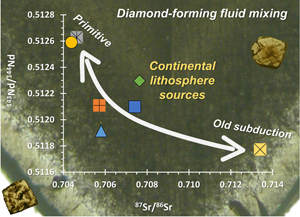 | Sr-Nd-Pb isotopes of fluids in diamond record two-stage modification of the continental lithosphere Abstract: High-density fluid (HDF) microinclusions in diamonds allow direct investigation of deep carbon- and water-rich fluids that influence the properties of Earth’s mantle. Identifying the sources and evolution of such fluids in the context of different potential mantle reservoirs is difficult due to the limited radiogenic isotope data. Here, we report Sr-Nd-Pb isotope compositions of silicic to low-Mg carbonatitic HDFs in a suite of diamonds from a single source in Canada. Relationships between isotopes and trace element compositions indicate the contribution of two distinct sources within the continental lithosphere: one with relatively primitive isotopic compositions characterised by ɛNd of −0.2, 87Sr/86Sr of 0.7044 and 206Pb/204Pb of 17.52, and another with more unradiogenic ɛNd < −16 and radiogenic 87Sr/86Sr and 206Pb/204Pb > 0.713 and 18.3, respectively. We suggest that the latter reflects an old metasomatic event in the continental lithosphere involving fluid addition from a subducting slab, most probably in the Paleoproterozoic. HDFs formed and their host diamonds crystallised in a more recent metasomatic event, indicated by the unaggregated nitrogen of the diamonds, where fluids from both sources mixed. HDFs from Canada, Botswana, and Congo have comparable isotope-trace element relationships, suggesting contributions of similar sources in distinct lithospheric provinces worldwide. |
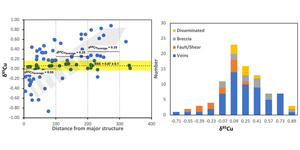 | A magmatic copper and fluid source for the sediment-hosted Mount Isa deposit Abstract: The world class Mount Isa deposit is a unique, sediment-hosted, copper deposit with no known equivalent around the world and a controversial origin. We report δ65Cu values (n = 90) from chalcopyrite grains collected systematically across the entire deposit. The δ65Cu shows a unimodal distribution with limited variability (min = −0.87 ‰; max = 0.88 ‰) and an average value (+0.13 ‰) comparable to average igneous rocks. In general, the δ65Cu values in chalcopyrite are lower near major structures and heavier further away, consistent with equilibrium fractionation with distance from the fluid source. The range in δ65Cu of chalcopyrite from the Mount Isa deposit is less variable compared to sedimentary copper, VMS and porphyry/epithermal deposits, but similar to Michigan deposits; meanwhile, average δ65Cu at Mt. Isa is distinctly higher than sedimentary copper deposits, but similar to VMS, porphyry/epithermal and Michigan deposits. These data suggest that, from a copper isotope perspective, the Mount Isa deposit is clearly different from sedimentary copper deposits and more like VMS, porphyry copper/epithermal and Michigan style deposits. The average δ65Cu (+0.13 ‰) is almost identical to the average δ65Cu (+0.14 ‰) from Proterozoic basalts and suggests that copper was sourced from the underlying mafic rocks; the limited fractionation and the normal distribution of the δ65Cu indicate a very effective leaching mechanism and transport by a hot fluid from which chalcopyrite precipitated without significant fractionation of copper isotopes. |
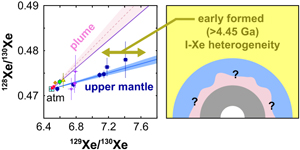 | Primordial noble gas isotopes from immoderate crushing of an Icelandic basalt glass Abstract: Noble gas isotopes carry important information about volatile accretion, mantle differentiation and the preservation of early formed radiogenic isotope heterogeneities. However, extremely low abundances and pervasive atmospheric contamination make precise determinations of mantle source heavy noble gas isotopic compositions challenging. Furthermore, the precision achieved in ratios of the rarest noble gas isotopes (the primordial isotopes) is typically poor. Here an approach that combines heavy crushing of a large quantity of sample along with more traditional temperate crushing is adopted to analyse noble gases in a basalt glass from Iceland. The method yields high precision Xe primordial isotope data resolved from the atmospheric composition. 128Xe/130Xe–129Xe/130Xe systematics indicate a distinct, low 129Xe/130Xe in the plume mantle source compared with that in the upper mantle, demonstrating the survival of an early formed (>4.45 Ga) radiogenic isotope heterogeneity in the modern mantle. Future sampling efforts may plan to dedicate large quantities (>20 g) of material for high precision noble gas analysis to leverage the advantages of a mixed analytical approach. |
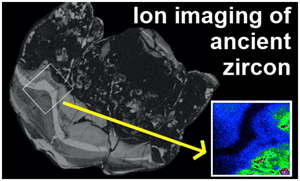 | Ion imaging of ancient zircon Abstract: The Idiwhaa gneiss, part of the Acasta Gneiss Complex, Canada, is a key source of information concerning formation of continental crust on the early Earth. However, zircon crystals from this oldest dated felsic crust were affected by multiple stages of alteration and metamorphism, leading to difficulties in disentangling primary from secondary processes. These grains provide an opportunity to understand the alteration processes that affect ancient zircon crystals. Ion imaging reveals pervasive recrystallisation fronts extending inwards from the margins of grains. Ahead of these recrystallisation fronts, grain cores contain isolated pockets of amorphous, but concordant, 3.99 Ga zircon that evidently escaped post-magmatic modification of U and Pb. The transport of these elements, involving the decoupling of parent and daughter isotopes, is highly heterogeneous over space and time within metamict zircon, yet localised domains still retain primary age information. Our data indicate that metamictisation of zircon alone does not lead to radiogenic Pb loss, which requires interaction with fluid. |
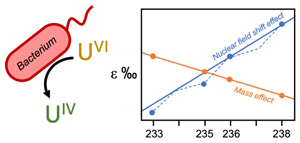 | Contribution of the nuclear field shift to kinetic uranium isotope fractionation Abstract: Isotopic fractionation of heavy elements (e.g., >100 amu) often invokes the nuclear field shift effect, which is due to the impact of the elements’ large nuclei on electron density. In particular, it has been explicitly described for uranium (U) at equilibrium and during kinetic isotope fractionation in abiotic mercury reactions. By following the fractionation of 233U, 235U, 236U and 238U during the enzymatic reduction of hexavalent U to tetravalent U by the bacterium Shewanella oneidensis, we provide the first direct evidence of the nuclear field shift effect during biologically controlled kinetic isotope fractionation. Here, we observed the odd-even staggering trend between fractionation factors of each isotope and their nuclear masses, and show that fractionation factors are correlated better with the nuclear volume than the mass. Additionally, by computing the relative contributions of the conventional mass-dependent effect (vibrational energy) and the mass-independent effect (nuclear field shift), we demonstrate that the experimental nuclear field shift effect is smaller than the calculated equilibrium value and that this discrepancy is responsible for the kinetic fractionation factor being lower than that predicted at equilibrium. |
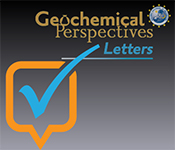 | Corrigendum to “Inferred pyrite growth via the particle attachment pathway in the presence of trace metals” by Domingos et al., 2023 |
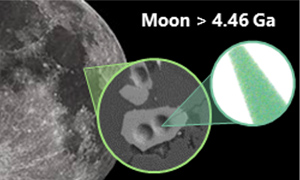 | 4.46 Ga zircons anchor chronology of lunar magma ocean Abstract: The crystallisation ages of lunar samples provide critical constraints on the minimum formation age of the Moon and its early evolution. Zircon crystals from Apollo 17 lunar impact melt breccia 72255 preserve ancient domains with a concordant average uranium-lead radiometric date of 4460 ± 31 Ma (Zhang |
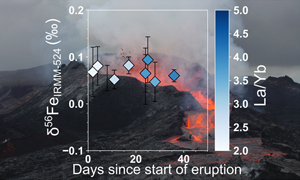 | No V-Fe-Zn isotopic variation in basalts from the 2021 Fagradalsfjall eruption Abstract: The Earth’s mantle is chemically heterogeneous in space and time, which is often reflected by variable isotopic compositions of mantle derived basalts. Basalts from the first 40 days of the 2021 Fagradalsfjall eruption, Reykjanes Peninsula, Iceland, display systematic temporal variations in the ratios of incompatible elements alongside resolvable variations in Sr, Nd and Pb radiogenic isotopes. These variations reflect progressive influx of magma derived from melting of a deeper, more enriched and potentially lithologically distinct source. We use this eruptive time series to conduct the first combined V-Fe-Zn isotope study, exploring the sensitivity of the combined isotopic approach, with particular focus on fingerprinting source lithological heterogeneity. We find no analytically resolvable change in V (δ51VAA between −0.95 ± 0.09 ‰ 2 s.d. and −0.86 ± 0.07 ‰ 2 s.d.), Fe (δ56FeIRMM-524 between +0.047 ± 0.042 ‰ 2 s.d. and +0.094 ± 0.049 ‰ 2 s.d.) and Zn (δ66ZnAA-ETH between −0.042 ± 0.003 ‰ 2 s.d. and +0.013 ± 0.027 ‰ 2 s.d.) isotopic compositions. The lack of variability in V-Fe-Zn isotopes, despite the evolving trace element and radiogenic isotope ratios, suggests there is no significant contribution of melts from a lithologically distinct (pyroxenite) mantle component under the Reykjanes Peninsula. |
<< Previous issueNext issue >>





